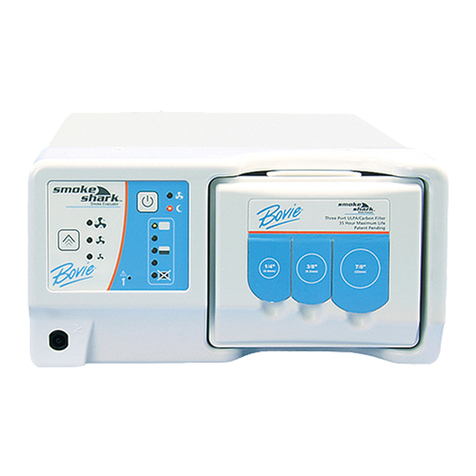Bovie Aaron 1250 User manual

1Service Guide • Aaron 1250
SERVICE GUIDE

PREFACE
This Service Guide and the equipment it describes are for qualified technicians who maintain and repair the Aaron
1250 Electrosurgical Generator. Additional User information is available in the Aaron 1250 Electrosurgical Generator
User’s Guide.
This document covers technical descriptions of the Aaron 1250 including its physical appearance, all operator con-
trols and indications, operational specifications, component functional descriptions (module level), diagrams of the
electronic circuits used, and troubleshooting guidelines (with chart comparisons).
The Aaron 1250 was constructed with the highest quality components, and was built in a registered
environment. In the unlikely event that your generator fails within 1 year of purchase date, Bovie / Aaron Medical
will warranty the product and effect factory repairs. Please refer to Appendix A Warranty for what is covered, how
long, and “How to Receive a Return Authorization Number”.
Equipment covered in this manual
Aaron 1250 Electrosurgical Generator (110 VAC Model) A1250
Aaron 1250 Electrosurgical Generator (220 VAC Model) A1250-220
For Information Call
Bovie Aaron Medical • St. Petersburg, FL 33710
U.S. Phone 1-800-537-2790 Fax 1-800-323-1640 • International Phone +1-727-384-2323 Fax +1-727-347-9144
EU Authorized Representative:
Peter J. Smith Medical Products Marketing
18 Yeates Close
Thame OX9 3AR
United Kingdom
Made in USA
Printed in USA
©2006 Bovie Aaron Medical, A Bovie Company.
All rights reserved.
Contents of this publication may not be reproduced without the written permission of Bovie Aaron Medical.
Bovie Aaron part number, MC-55-039-001 Rev. 3
2Bovie / Aaron Medical

SAFETY PRECAUTIONS WHEN OPERATING THE GENERATOR
The safe and effective use of electrosurgery depends to a large degree on factors solely under the control of the
operator. There is no substitute for a properly trained and vigilant medical staff. It is important that they read,
understand, and follow the operating instructions supplied with this electrosurgical equipment.
To promote the safe use of the Aaron 1250 Electrosurgical Generator, please refer to the User’s Guide for standard
operating precautions.
APPLICABLE SAFETY STANDARDS
CSA C22.2, NO. 601.1 – M90
UL 2601 – 1 – UL
IEC 60601 – 2 – 2 (1998 – 90) CLASS 1 EQUIPMENT, TYPE BF
CENELEC EN 60601 – 1 – 2
FCC PART 15, CLASS A
IEC 60601-1 2nd Edition (1988)
CONVENTIONS USED IN THIS GUIDE
WARNING
Indicates a potentially hazardous situation which, if not avoided, could result in death or serious
injury.
CAUTION
Indicates a hazardous situation which, if not avoided, may result in minor or moderate injury.
NOTICE
Indicates an operating tip, a maintenance suggestion, or a hazard that may result in product
damage.
3Service Guide • Aaron 1250

Table of Contents
Preface .....................................................................................................................................2
Safety Precautions when Operating the Generator ...............................................................3
Applicable Safety Standards ...................................................................................................3
Conventions Used in this Guide ...........................................................................................3
List of Figures .........................................................................................................................7
List of Board Drawings and Schematics ................................................................................7
Section 1. The Aaron 1250 Electrosurgical Generator
Functional Description .........................................................................................................10
Unit Description ...................................................................................................................11
Safety Precautions when Repairing the Generator ..............................................................11
General Warnings, Cautions, and Notices ...................................................................11
Active Accessories ..........................................................................................................11
Fire / Explosion Hazards ..............................................................................................12
Generator Electric Shock Hazards ................................................................................12
Servicing ........................................................................................................................13
Cleaning ........................................................................................................................13
Section 2. Controls, Indicators, and Receptacles
Front Panel ............................................................................................................................16
Controls and Indicators Overview .......................................................................................17
Cut and Blend Controls .......................................................................................................18
Coag and Bipolar Controls ..................................................................................................19
Indicators ..............................................................................................................................20
Power Switch and Receptacles ..............................................................................................21
Symbols on the Front Panel .................................................................................................22
Rear Panel .............................................................................................................................23
Symbols on the Rear Panel ..................................................................................................23
Section 3. Technical Specifications
Performance Characteristics .................................................................................................25
Input Power ...................................................................................................................25
Duty Cycle .....................................................................................................................26
Dimensions and Weight ...............................................................................................26
Operating Parameters ....................................................................................................26
Transport and Storage ...................................................................................................26
Audio Volume ...............................................................................................................26
Patient Return Electrode Sensing .................................................................................27
Low Frequency (50–60 Hz) Leakage Current ...............................................................27
High Frequency (RF) Leakage Current .........................................................................27
Standards and IEC Classifications .......................................................................................28
Class I Equipment (IEC 60601-1) ................................................................................28
Type BF Equipment (IEC 60601-1)/Defibrillator Proof ..............................................28
Drip Proof (IEC 60601-2-2) ..........................................................................................28
Electromagnetic Interference ........................................................................................28
Electromagnetic Compatibility (IEC 60601-1-2 and IEC 60601-2-2) ..........................28
Voltage Transients (Emergency Generator Mains Transfer) .........................................28
Output Power Characteristics ..............................................................................................28
Maximum Output for Bipolar and Monopolar Modes ...............................................28
Output Power Curves ...........................................................................................................29
4Bovie / Aaron Medical

Monopolar Cut Curves .................................................................................................29
Monopolar Coag Curves ......................................................................................................31
Bipolar Curves ......................................................................................................................33
Reference Output Waveforms ..............................................................................................34
Section 4. Theory Of Operation
Block Diagram ......................................................................................................................38
Functional Overview of Key Circuits ...................................................................................38
High Voltage DC Supply ......................................................................................................38
Low Voltage DC Supplies ....................................................................................................38
DC Supply Check Circuit ....................................................................................................39
Temperature Sensing Circuit ................................................................................................39
Four Request Activation Sensing Circuits ...........................................................................39
Speaker Circuit .....................................................................................................................39
Patient Return Electrode Sensing Circuit ............................................................................39
RF Amplifier Circuit ............................................................................................................40
Monopolar Select Circuit .....................................................................................................40
Monopolar / Bipolar Select Relays ......................................................................................40
Controls and Indicators .......................................................................................................40
Digital PWM Circuit ............................................................................................................40
System Logic .........................................................................................................................40
Aaron 1250 Control Signal Inputs and Outputs ................................................................41
Section 5. Operating the Aaron 1250
Inspecting the Generator and Accessories ...........................................................................46
Service Personnel Safety .......................................................................................................46
Installation and Placement ...................................................................................................47
Functional (Operational) Checks .........................................................................................47
How to Set Up and Start the Aaron 1250 Unit ..................................................................47
How to Check the Patient Return Electrode Alarm Function ............................................47
How to Check the Bipolar Mode (with Footswitch) ...........................................................48
How to Check the Monopolar Mode (with Footswitch) .....................................................48
How to Check the Monopolar Mode (with Handswitch) ...................................................48
Operating the Unit ...............................................................................................................49
Section 6. Maintenance
Cleaning the Unit ................................................................................................................52
Performing Periodic Inspection ............................................................................................52
Replacing Fuses .....................................................................................................................52
Section 7. Troubleshooting
Recommended Equipment for Troubleshooting .................................................................54
Troubleshooting the Aaron 1250 .........................................................................................54
Inspecting the Generator .....................................................................................................54
Inspecting the Receptacles ....................................................................................................54
Inspecting Internal Components .........................................................................................55
Understanding Error Codes and Audio Tones ...................................................................56
Correcting Common Problems ............................................................................................57
Main Board Test Points ........................................................................................................61
Display Board Test Points .....................................................................................................61
5Service Guide • Aaron 1250

Section 8. Repair Policy and Procedures
Responsibility of the Manufacturer .....................................................................................64
Returning the Generator for Service ...................................................................................64
Obtain a Return Authorization Number .............................................................................64
Clean the Generator .............................................................................................................64
Ship the Generator ...............................................................................................................64
Appendix A. Warranty.........................................................................................................65
Appendix B. Board Drawings and Schematics ...................................................................67
6Bovie / Aaron Medical

List of Figures
Figure 2-1 Layout of controls, indicators, and receptacles on the front panel ..................16
Figure 2-2 Controls for the Cut and Blend modes ............................................................18
Figure 2-3 Controls for the Coagulation, Fulguration, and Bipolar modes ......................19
Figure 2-4 Indicators for power, return electrodes, and footswitch control .......................20
Figure 2-5 Location of the unit power switch and front panel receptacles ........................21
Figure 2-6 Layout of connectors and controls on the rear panel .......................................23
Figure 3-1 Output power vs. impedance for Cut mode .....................................................29
Figure 3-2 Peak voltage vs. power setting for Cut mode .....................................................29
Figure 3-3 Output power vs. impedance for Blend mode ..................................................30
Figure 3-4 Peak voltage vs. power setting for Blend mode .................................................30
Figure 3-5 Output power vs. impedance for Coagulation mode ........................................31
Figure 3-6 Peak voltage vs. power setting for Coagulation mode .......................................31
Figure 3-7 Output power vs. impedance for Fulguration mode .........................................32
Figure 3-8 Peak voltage vs. power setting for Fulguration mode ........................................32
Figure 3-9 Output power vs. impedance for Bipolar mode ................................................33
Figure 3-10 Peak voltage vs. power setting for Bipolar mode .............................................33
Figure 3-11 Cut mode waveform .........................................................................................34
Figure 3-12 Blend mode waveform .....................................................................................34
Figure 3-13 Coagulation mode waveform ...........................................................................35
Figure 3-14 Fulguration mode waveform ............................................................................35
Figure 3-15 Bipolar mode waveform ...................................................................................36
Figure 4-1 Functional block diagram of the Aaron 1250 system .......................................38
Board Drawings and Schematics
Schematic 1 Main board .....................................................................................................69
Schematic 2 Power Supply ...................................................................................................70
Schematic 3 RF Amplifier Circuit ......................................................................................71
Schematic 4 Request Sense Circuit Hand A ......................................................................72
Schematic 5 Request Sense Circuit Hand B .......................................................................73
Schematic 6 Request Sense Circuit Foot A ........................................................................74
Schematic 7 Request Sense Circuit Foot B .........................................................................75
Schematic 8 Display Board ..................................................................................................76
Schematic 9 Display Logic ...................................................................................................77
Schematic 10 Monopolar Select Circuit .............................................................................78
Schematic 11 Main Printed Circuit Board .........................................................................79
Schematic 12 Display Printed Circuit Boards ....................................................................80
Schematic 13 Relay Printed Circuit Board .........................................................................81
Schematic 14 Final Assembly ..............................................................................................82
Schematic 15 Front Panel Assembly ...................................................................................83
Schematic 16 Back Panel Assembly .....................................................................................84
7Service Guide • Aaron 1250

8Bovie / Aaron Medical

THE AARON 1250 ELECTROSURGICAL GENERATOR
This section includes the following information:
Functional Description
Unit Description
Safety precautions when Repairing the Generator
General Warnings, Cautions, and Notices
Active Accessories
Fire/Explosion Hazards
Generator Electric Shock Hazards
Servicing
Cleaning
CAUTION
Read all warnings, cautions, and instructions provided with this generator before using.
Read the instructions, warnings, and cautions provided with electrosurgical accessories before
using. Specific instructions are not included in this manual.
9Service Guide • Aaron 1250

FUNCTIONAL DESCRIPTION
The Aaron 1250 is a multipurpose electrosurgical generator for use in physician’s offices and surgi-centers. It provides
unsurpassed performance, flexibility, reliability, and user convenience in one compact package.
The Aaron 1250 Electrosurgical Generator includes digital technology. This new technology is evident in the self-
checking circuitry and error code readouts. The unit offers monopolar and bipolar electrosurgical operations.
The following are Aaron 1250 key advantages and benefits.
Power Capabilities Up to 120 watts of Pure Cut @ 500 Ω.
Up to 90 watts of Blend @ 800 Ω.
Up to 80 watts of Coagulation @ 1000 Ω.
Up to 40 watts of Fulguration @ 1000 Ω.
Up to 30 watts of Bipolar @ 200 Ω.
Two Levels of Coagulation: Pinpoint coagulation provides precise control of bleeding
Pinpoint Coagulation and Fulguration in localized areas.
Fulguration provides greater control of bleeding in highly
vascular tissue over broader tissue surface areas.
Return Electrode Monitoring System The unit incorporates a return electrode contact quality
monitoring system (RECQMS). This system determines
the type of patient return electrode attached (single plate
or split plate).
It also continuously monitors the contact impedance
between the patient and the split plate patient return
electrode.
Contact impedance is only monitored when approved split
plate patient return electrodes are used.
Memory The generator automatically powers up to the last modes
selected, and previously set power settings.
Floating RF Output This minimizes the potential of alternate site burns.
Standard Front Panel Connectors These connectors accept the latest monopolar and bipolar
instruments.
Self Diagnostics These diagnostics continually monitor the unit to ensure
proper performance.
Whenever they detect a problem, medical personnel
receive audible and visual alarm responses, and the output
is suspended until the alarm condition is cleared.
10 Bovie / Aaron Medical

UNIT DESCRIPTION
The Aaron 1250 electrosurgical generator is a self-contained unit, consisting of the main enclosure and power cord.
The main components incorporated in the generator include:
•FRONT PANEL COMPONENTS Power switch; two dials for controlling power output; membrane switches for
selecting modes; receptacles for connecting electrosurgical accessories; and indicators that show the current settings
and patient return electrode status.
•REAR PANEL COMPONENTS Volume control; footswitch receptacle; power cable receptacle and fuse holder;
equipotential grounding lug; and remote accessory receptacle.
•INTERNAL COMPONENTS Display board; main board; pad sensing module; speaker board; and relay board.
SAFETY PRECAUTIONS WHEN REPAIRING THE GENERATOR
Before servicing the Aaron 1250 Generator it is important that you read, understand, and follow the instructions
supplied with it. Also, be familiar with any other equipment used to install, test, adjust, or repair this generator.
General Warnings, Cautions, and Notices
WARNINGS
Use the generator only if the self-test has been completed as described. Otherwise, inaccurate
power outputs may result.
The instrument receptacles on this generator are designed to accept only one instrument at a
time. Do not attempt to connect more than one instrument at a time into a given receptacle.
Doing so will cause simultaneous activation of the instruments.
CAUTIONS
Do not stack equipment on top of the generator or place the generator on top of electrical
equipment. These configurations are unstable and / or do not allow adequate cooling.
Provide as much distance as possible between the electrosurgical generator and other electronic
equipment (such as monitors). An activated electrosurgical generator may cause electrical
interference with them.
Do not turn the activation tone down to an inaudible level. The activation tone alerts the surgical
team when an accessory is active.
NOTICES
If required by local codes, connect the generator to the hospital equalization (grounding) connector
with an equipotential cable.
Connect the power cord to a wall receptacle having the correct voltage. Otherwise, product dam-
age may result.
Active Accessories
WARNINGS
Shock Hazard
– Do not connect wet accessories to the generator.
Shock Hazard
– Ensure that all accessories and adapters are correctly connected and that no
metal is exposed.
11Service Guide • Aaron 1250

CAUTIONS
Accessories must be connected to the proper receptacle type. In particular, bipolar accessories
must be connected to the Bipolar Instrument receptacle only. Improper connection may result in
inadvertent generator activation or a Contact Quality Monitor alarm.
Set power levels to the lowest setting before testing an accessory.
NOTICE
During Bipolar Electrosurgery, do not activate the generator until the forceps have made contact
with the patient. Product damage may occur.
Fire / Explosion Hazards
WARNINGS
Explosion Hazard
– Do not install the generator in the presence of flammable anesthetics, gases,
liquids, or objects.
Fire Hazard
– Do not place active accessories near or in contact with flammable materials (such
as gauze or surgical drapes). Electrosurgical accessories that are activated or hot from use can
cause a fire. Use a holster to hold electrosurgical accessories safely away from personnel and
flammable materials.
Fire Hazard
– Do not use extension cords.
Fire Hazard
– For continued protection against fire hazard, replace fuses only with fuses of the
same type and rating as the original fuse.
Generator Electric Shock Hazards
WARNINGS
Connect the generator power cord to a properly grounded receptacle. Do not use power plug
adapters.
Do not connect a wet power cord to the generator or to the wall receptacle.
To allow stored energy to dissipate after power is disconnected (caps discharge) wait at least five
minutes before replacing parts.
Always turn off and unplug the generator before cleaning.
Do not touch any exposed wiring or conductive surfaces while the generator is disassembled and
energized. Never wear a grounding strap when working on an energized generator.
When taking troubleshooting measurements use appropriate precautions such as using isolated
tools and equipment, using the “one hand rule,” etc.
Potentially lethal AC and DC voltages are present in the AC line circuitry, high voltage DC circuitry,
and associated mounting and heat sink hardware described in this manual. These potentials are
not isolated from the AC line. Take appropriate precautions when testing and troubleshooting this
area of the generator.
High frequency, high voltage signals that can cause severe burns are present in the RF output
stage and in the associated mounting and heat sink hardware. Take appropriate precautions when
testing and troubleshooting this area of the generator.
12 Bovie / Aaron Medical

Servicing
CAUTION
Read all warnings, cautions, and instructions provided with this generator before servicing.
The generator contains electrostatic-sensitive components. When repairing the generator, work at
a static-control workstation. Wear a grounding strap when handling electrostatic-sensitive compo-
nents, except when working on an energized generator. Handle circuit boards by their nonconduc-
tive edges. Use an anti-static container for transport of electrostatic-sensitive components and cir-
cuit boards.
NOTICE
After installing a new low voltage power supply, verify that the voltages are correct.
Cleaning
NOTICE
Do not clean the generator with abrasive cleaning or disinfectant compounds, solvents, or other
materials that could scratch the panels or damage the generator.
13Service Guide • Aaron 1250

14 Bovie / Aaron Medical

CONTROLS, INDICATORS, AND RECEPTACLES
This section describes the front and rear panels, including all controls, indicators, receptacles, the fuse drawer,
and ports.
15Service Guide • Aaron 1250

FRONT PANEL
Figure 2-1 Layout of controls, indicators, and receptacles on the front panel
16 Bovie / Aaron Medical

CONTROLS AND INDICATORS OVERVIEW
Users may control most Aaron 1250 functions from the front panel. Each Control is plainly marked and
colored on the front panel for quick reference. Volume control and a footswitch connector are located on
the rear panel.
Normal operations involve activating the generator with either a front connected handswitch OR a rear-
connected footswitch. The following components are the User Interface for the Aaron 1250 Electrosurgical
Generator.
Power Switch The rocker ON / OFF switch on the lower left corner
allows the Aaron 1250 to be shut off when the unit is not
in use.
Membrane Function Switches The front panel overlay contains 6 membrane function
switches (sometimes called matrix switches). There is a
membrane switch dedicated for each operational mode.
These switches toggle the unit between mode settings.
Power Control Knob These rotary knobs allow you to select the desired
RF power level for all modes of operation. The Power
Control Knobs move at a graduated 1 watt per notch
(incrementally).
Watts Display A & B (Cut and Coag) These large Power Output Displays report the generator’s
output power setting from 1 to 120 watts in 1 watt
increments (at the rated load). During operation, the
numeral output of the display gives the surgeon an
indication of available generator power.
Visual LED Indictors Mode LEDs indicate the mode setting.
The YELLOW indicators and controls indicate cutting
and blending operations. A yellow field LED indicates that
either a Cut or Blend mode is activated.
The BLUE indicators and controls indicate Coagulation,
Fulguration, and Bipolar operation. The blue field LED
indicates either Coagulation, Fulguration or Bipolar mode
is activated.
The Footswitch Control LED Indicator indicates which
mode the footswitch is presently in.
Monopolar footswitch control allows the user to activate
the monopolar mode when using footswitch controlled
accessories.
Bipolar footswitch control allows the user to activate the
bipolar mode.
17Service Guide • Aaron 1250

Visual LED Indictors A Return Electrode Indicator displays which type of
patient Return Electrode is attached to the patient. It also
has an associated audio alarm that sounds when a patient
return electrode is not detected during activation.
Audible Indicators An activation tone sounds whenever the Aaron 1250
Electrosurgical Generator is activated. The volume may be
adjusted up or down on the rear of the unit.
An Alarm Siren sounds during all alarm conditions. The
volume of this alarm cannot be adjusted.
CUT AND BLEND CONTROLS
Figure 2-2 Controls for the Cut and Blend modes
18 Bovie / Aaron Medical
Cut
Blend
Cut
Cut Indicator
Illuminates when
Pure Cut Mode
is selected.
Cut and Blend
Activation Indicator
Illuminates when you
activate either Pure Cut
or Blend Mode.
Cut and Blend Power Control Dial
Increases or decreases the Cut or Blend
power output in increments of 1 watt.
Cut and Blend
Power Display (watts)
Indicates the power set for the
Pure Cut or Blend Mode.
Blend Indicator
Illuminates when
Blend Mode
is selected.
Cut Selector
When pressed, selects
the Pure Cut Mode.
Blend Selector
When pressed, selects
the Blend Mode.

COAG AND BIPOLAR CONTROLS
Figure 2-3 Controls for the Coagulation, Fulguration, and Bipolar modes
19Service Guide • Aaron 1250
Cut
Blend
Cut
Coag and Bipolar
Activation Indicator
Illuminates when you
activate Coagulation,
Fulguration, or
Bipolar Mode.
Coag and Bipolar Power Control Dial
Increases or decreases the Coag or Bipolar
power output in increments of 1 watt.
Coag and Bipolar
Power Display (watts)
Indicates the power set for
any Coag or Bipolar Mode.
Coagulation Indicator
Illuminates when
Coagulation Mode
is selected.
Fulguration Indicator
Illuminates when
Fulguration Mode
is selected.
Bipolar Indicator
Illuminates when
Bipolar Mode
is selected.
Coagulation Selector
When pressed, selects
the Coagulation Mode.
Fulguration Selector
When pressed, selects
the Fulguration Mode.
Bipolar Selector
When pressed, selects
the Bipolar Mode.

INDICATORS
Figure 2-4 Indicators for power, return electrodes, and footswitch control
20 Bovie / Aaron Medical
Power Indicator
Illuminates when
the unit is on.
Split-Plate Patient Return
Electrode Indicator
Illuminates when the system
detects a split plate.
Single Plate Patient Return
Electrode Indicator
Illuminates when the system
detects a single plate.
Monopolar Footswitch
Control Indicator
Illuminates when monopolar
footswitch control is selected.
Bipolar Footswitch
Control Indicator
Illuminates when bipolar
footswitch control is selected.
Patient Return Electrode
Alarm Indicator
Illuminates when the system
detects a patient return
electrode alarm condition.
Footswitch Control
Selector
When pressed, toggles
between monopolar
and bipolar foot control.
Other manuals for Aaron 1250
1
Table of contents
Other Bovie Medical Equipment manuals
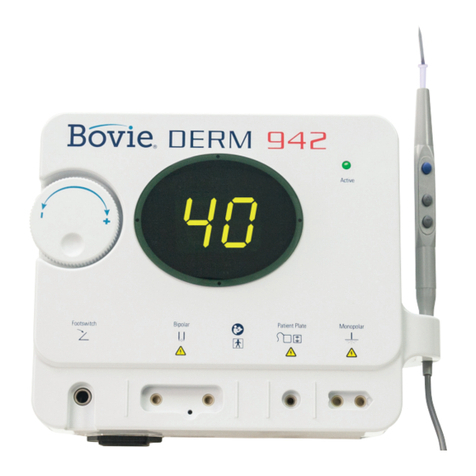
Bovie
Bovie DERM 941 User manual
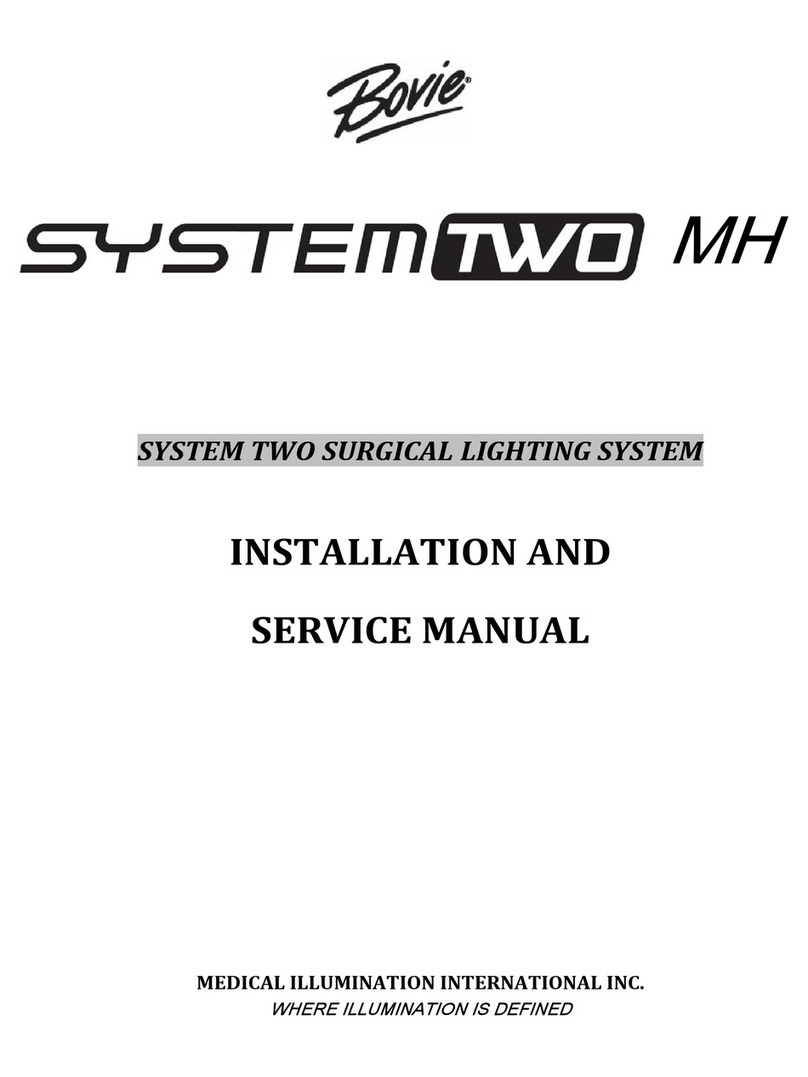
Bovie
Bovie System Two MH Manual
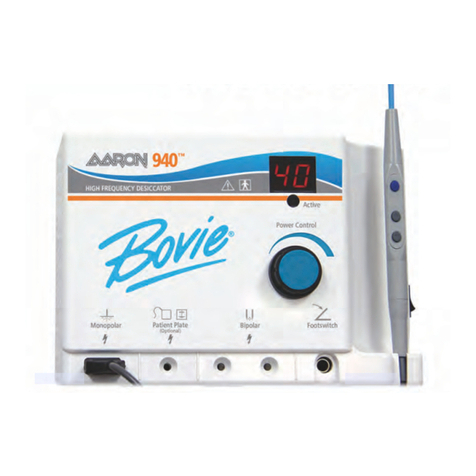
Bovie
Bovie Aaron 940 User manual
Bovie
Bovie Icon Gi User manual

Bovie
Bovie SPECIALIST PRO User manual
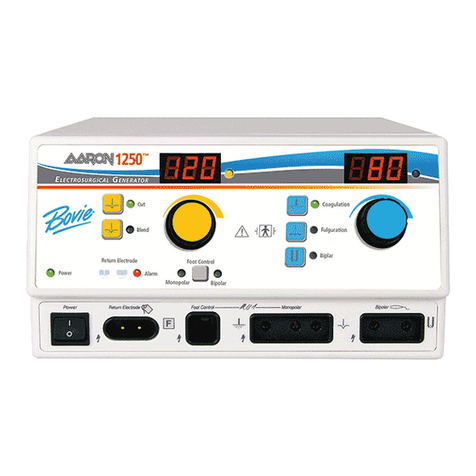
Bovie
Bovie Aaron 1250 User manual
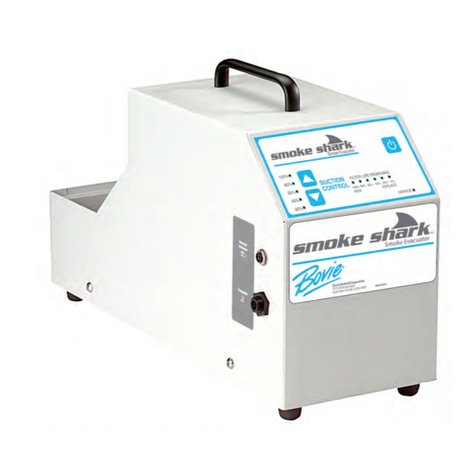
Bovie
Bovie Smoke Shark SE01 User manual

Bovie
Bovie Aaron 950 User manual
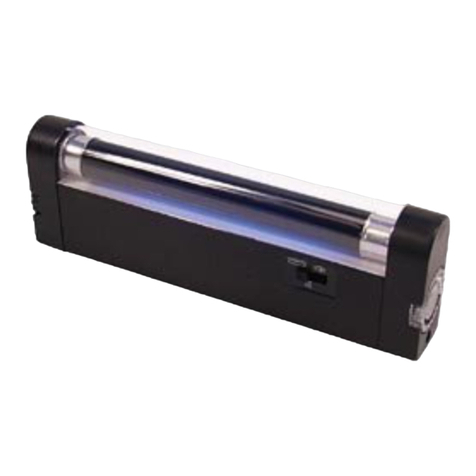
Bovie
Bovie UV59 User manual
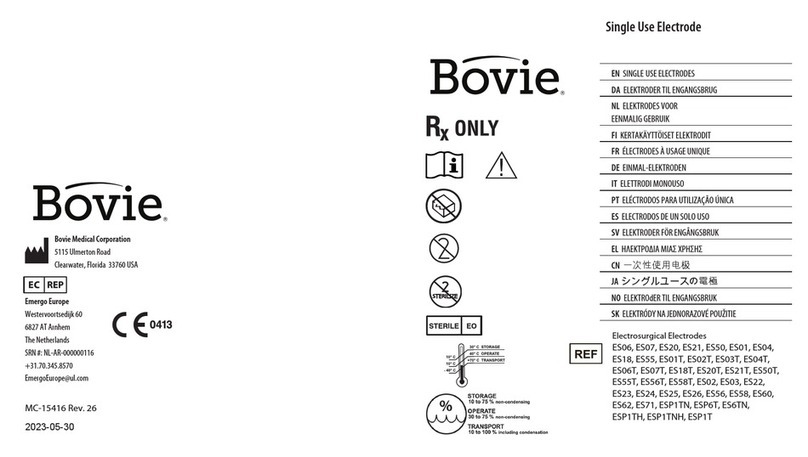
Bovie
Bovie ES06 User manual
Popular Medical Equipment manuals by other brands

Getinge
Getinge Arjohuntleigh Nimbus 3 Professional Instructions for use

Mettler Electronics
Mettler Electronics Sonicator 730 Maintenance manual

Pressalit Care
Pressalit Care R1100 Mounting instruction

Denas MS
Denas MS DENAS-T operating manual

bort medical
bort medical ActiveColor quick guide

AccuVein
AccuVein AV400 user manual
